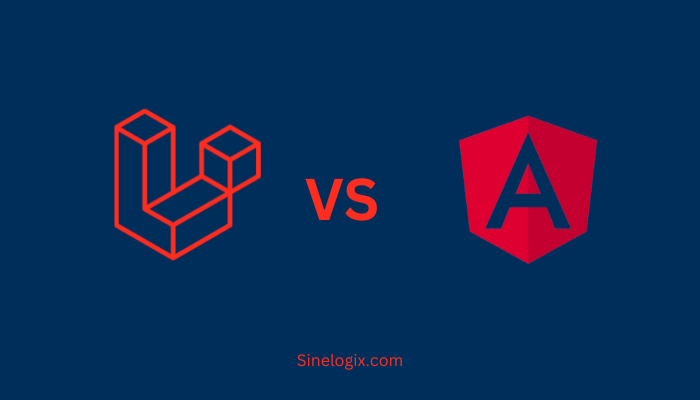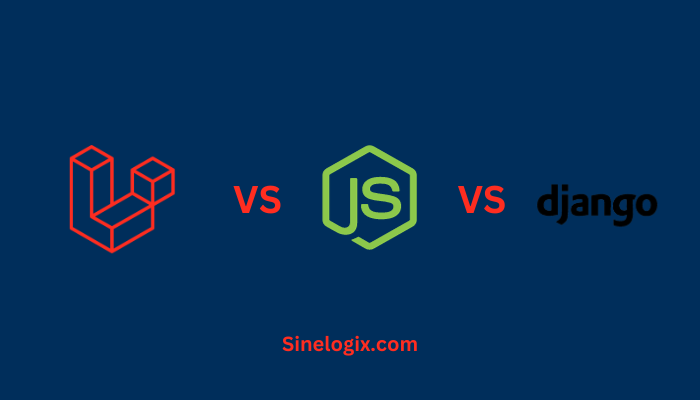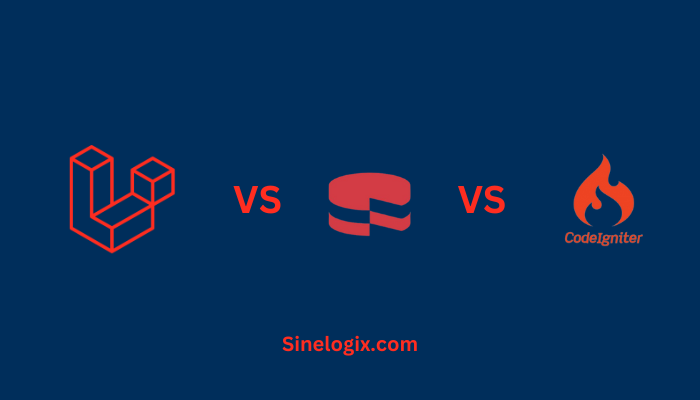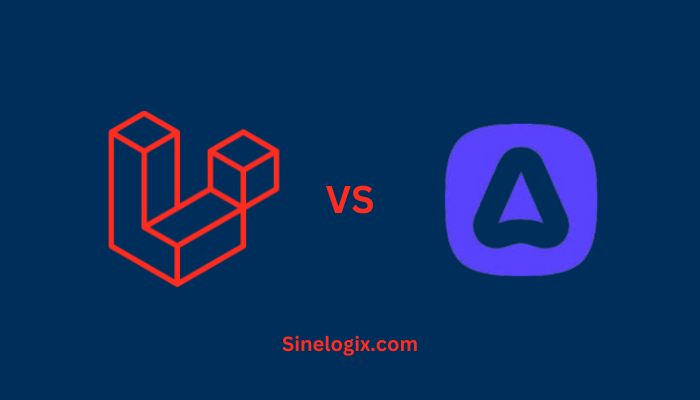In the ever-evolving landscape of web development, choosing the right tools and frameworks is crucial for building robust and scalable applications. Laravel and Angular stand out as two prominent players, each excelling in its domain.
In this article, we’ll dive into a detailed comparison of Laravel, a PHP web application framework, and Angular, a TypeScript-based front-end framework, to help you make an informed decision for your next project.
1. Introduction
Laravel
Laravel, an elegant PHP framework, has gained immense popularity for its expressive syntax, developer-friendly features, and a vibrant ecosystem. It follows the MVC (Model-View-Controller) architectural pattern, making it suitable for building dynamic and modern web applications.
Angular
Angular, developed and maintained by Google, is a robust front-end framework based on TypeScript. It employs a component-based architecture, providing a structured approach to building scalable and maintainable single-page applications (SPAs).
2. Language and Ecosystem
Laravel
PHP: Laravel leverages the power of PHP, a server-side scripting language widely used for web development. The PHP ecosystem is vast, with a multitude of libraries and packages available through Composer, Laravel’s dependency manager.
Angular
TypeScript: Angular is built on TypeScript, a superset of JavaScript that adds static typing to the language. TypeScript enhances code quality, readability, and maintainability. Angular benefits from the rich JavaScript ecosystem, with npm as its primary package manager.
3. Architecture
Laravel
MVC Pattern: Laravel’s adherence to the MVC architectural pattern separates concerns, making code organization and maintenance more straightforward. This separation enhances scalability and promotes clean coding practices.
Angular
Component-Based: Angular follows a component-based architecture, dividing the user interface into reusable and independent components. This approach facilitates code modularity and reusability, promoting a more maintainable codebase.
4. Performance
Laravel
Server-Side Rendering (SSR): Laravel primarily focuses on server-side rendering. While this approach is effective for many applications, it may lead to slower initial page loads compared to client-side rendering.
Angular
Client-Side Rendering (CSR): Angular, being a front-end framework, relies on client-side rendering. This can result in faster initial page loads, as the browser renders content dynamically. However, careful optimization is required to maintain performance as the application grows.
5. Learning Curve
Laravel
Developer-Friendly: Laravel is renowned for its intuitive syntax and developer-friendly features, making it accessible for developers with varying levels of experience in PHP.
Angular
Steeper Learning Curve: Angular’s comprehensive feature set and the use of TypeScript may pose a steeper learning curve, especially for developers new to front-end development. However, the structured approach pays off in terms of maintainability and scalability.
6. Community and Support
Laravel
Active Community: Laravel boasts a vibrant and active community. Laravel Forge, Laravel Mix, and other community-driven packages contribute to the ecosystem’s richness.
Angular
Backed by Google: Angular benefits from being developed and maintained by Google, ensuring strong community support. The official documentation is extensive, and regular updates enhance the framework’s capabilities.
7. Integration
Laravel
API Integration: Laravel excels in building APIs, making it an excellent choice for applications that require seamless integration with third-party services.
Angular
RESTful APIs: Angular seamlessly integrates with RESTful APIs, allowing developers to build dynamic and interactive user interfaces that communicate efficiently with the back end.
8. Use Cases
Laravel
Web Applications: Laravel is well-suited for building web applications of varying complexities, including content management systems, e-commerce platforms, and more.
Angular
Single-Page Applications (SPAs): Angular shines in the development of SPAs, offering a powerful framework for building dynamic, responsive, and feature-rich user interfaces.
9. Testing Capabilities
Laravel
PHPUnit Integration: Laravel comes with PHPUnit support out of the box, facilitating unit testing and ensuring code reliability. The framework encourages developers to write tests, contributing to the application’s overall stability.
Angular
Jasmine and Karma: Angular provides a testing environment with Jasmine for writing unit tests and Karma for test execution. This comprehensive testing setup promotes the development of robust and maintainable front-end code.
10. Flexibility and Extensibility
Laravel
Middleware and Packages: Laravel’s middleware system enables developers to customize HTTP request handling, adding a layer of flexibility. Additionally, Laravel’s rich ecosystem of packages allows developers to extend functionality seamlessly.
Angular
Custom Directives and Pipes: Angular offers flexibility through custom directives and pipes, enabling developers to extend HTML and create reusable components. The modular architecture encourages extensibility, allowing for the incorporation of third-party libraries.
11. Templating
Laravel
Blade Templating Engine: Laravel employs the Blade templating engine, providing a simple yet powerful syntax for dynamic content. Blade templates are easy to learn and offer features like template inheritance and sections.
Angular
HTML Templating: Angular uses HTML templates with data-binding, making it easy to create dynamic views. The separation of concerns between HTML templates and TypeScript code enhances code readability and maintainability.
12. Security
Laravel
Built-in Security Features: Laravel prioritizes security with features like hashed passwords, protection against SQL injection, and Cross-Site Scripting (XSS) prevention. The framework’s security features contribute to building secure applications. That’s why, for better security reasons business owners love to develop their site on Laravel with the help of our Laravel development services.
Angular
Cross-Site Scripting (XSS) Protection: Angular’s built-in features, such as data binding and sanitation, help prevent XSS attacks. The framework promotes secure coding practices and encourages developers to follow best practices for web security.
13. Tooling and Development Environment
Laravel
Artisan CLI: Laravel’s Artisan command-line interface automates various tasks, streamlining development. The availability of commands for migrations, database seeding, and more enhances the overall development experience.
Angular
Angular CLI: Angular provides a powerful command-line interface for tasks like project scaffolding, testing, and deployment. The Angular CLI simplifies common development tasks, promoting efficiency and consistency.
14. Community Engagement
Laravel
Laracasts and Forums: Laracasts, a popular online learning platform, contributes to the Laravel community’s education. Laravel forums provide a space for developers to seek advice, share knowledge, and engage with the community.
Angular
Angular Blog and Meetups: The official Angular blog offers updates, tutorials, and best practices. Local meetups and global conferences, such as ng-conf, foster community engagement, providing opportunities for learning and networking.
15. Mobile App Development
Laravel
Laravel as a Backend: Laravel can be used as a backend for mobile app development, providing a robust API for communication with mobile clients.
Angular
Ionic Framework: Angular seamlessly integrates with the Ionic framework for building cross-platform mobile apps. The combination of Angular and Ionic simplifies the development of high-quality mobile applications.
16. Documentation
Laravel
Clear and Extensive Documentation: Laravel’s documentation is well-organized, comprehensive, and beginner-friendly. It serves as a valuable resource for both novice and experienced developers.
Angular
Thorough Documentation: Angular’s documentation is extensive, covering everything from basic concepts to advanced topics. The official documentation is regularly updated, reflecting the framework’s evolving features and best practices.
17. Real-time Communication
Laravel
Laravel Echo and Pusher Integration: Laravel simplifies real-time communication through Laravel Echo, a WebSocket library. Combined with Pusher, a real-time messaging service, Laravel enables the development of interactive features like live updates and notifications.
Angular
WebSocket Support: Angular supports WebSocket communication, allowing developers to implement real-time features seamlessly. The use of libraries like Socket.io enhances Angular’s capabilities for building dynamic and collaborative applications.
Considering the increasing demand for real-time functionality in modern web applications, the ability to handle real-time communication efficiently is a crucial aspect to evaluate when choosing between Laravel and Angular. Both frameworks offer solutions, but the integration methods and ease of implementation may influence your decision based on the specific needs of your project.
18. State Management
Laravel
Session Handling: Laravel provides built-in support for session management, making it easy to store and retrieve user-specific data across multiple requests. This is particularly useful for handling user authentication and maintaining session state.
Angular
NgRx and Reactive State Management: Angular applications often benefit from using NgRx, a powerful state management library inspired by Redux. By implementing a reactive architecture, Angular ensures a predictable and centralized approach to managing application state, especially in complex scenarios.
Efficient state management is critical for maintaining a coherent and responsive user interface. Laravel’s session handling caters to server-side state management, while Angular’s NgRx empowers front-end developers with tools for managing complex state interactions. Choosing the right approach depends on your application’s architecture and the level of control you need over state management.




